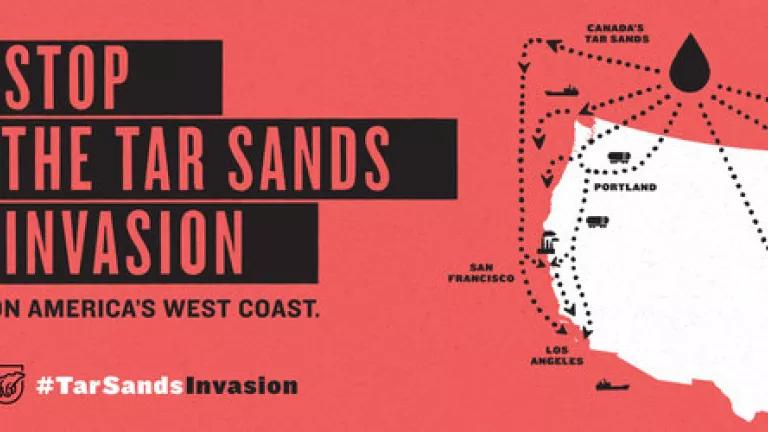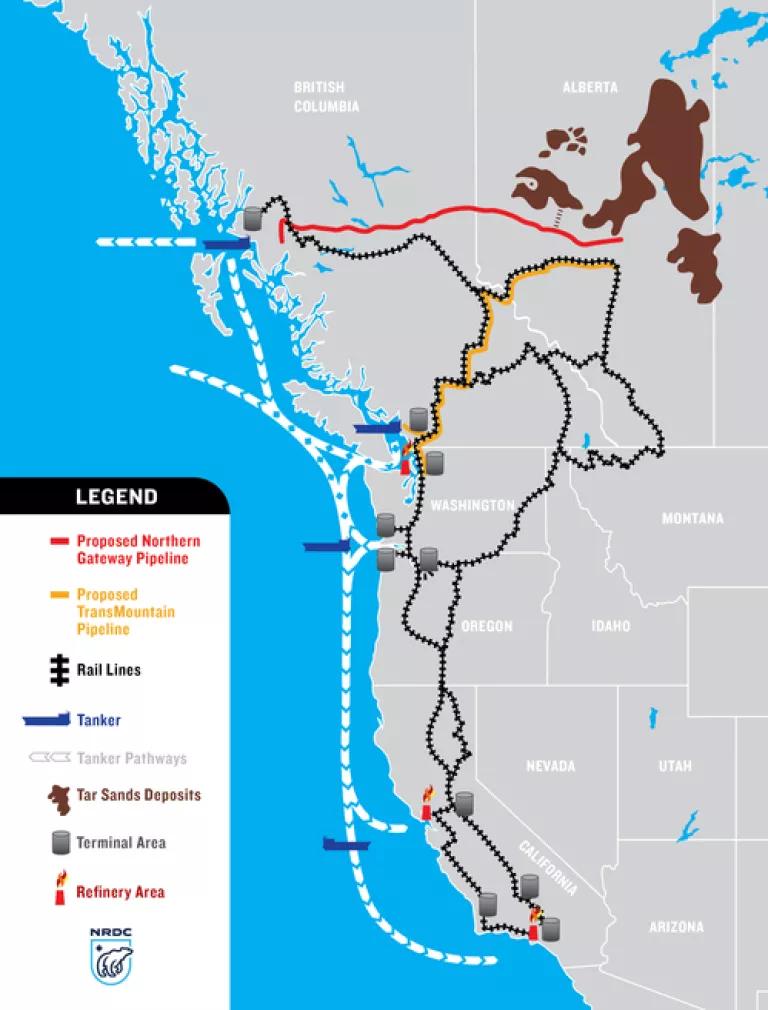
The West Coast could soon become a destination for huge volumes of tar sands crude oil - one of the world's dirtiest fuels - setting back efforts to combat climate change and exposing communities to significant new health and environmental risks. NRDC and a coalition of twenty-nine partners organization released a report - West Coast Tar Sands Invasion - that examines the spike in oil infrastructure, climate pollution, and public health risks that will result from oil industry proposals to expand tar sands refining and export capacity on the West Coast.
As the report details, in coming decades the amount of tar sands crude moving into and through the North American West Coast could increase by more than 1.7 million barrels per day (bpd) in coming decades if industry proposals for pipelines, tankers and rail facilities move forward. According to analysis by Borealis Centre Environment and Trade Research, nearly half of that tar sands - or 800,000 bpd - could be destined for refineries capable of processing heavy crude in California and Washington. This proposed tar sands invasion is a part of a massive expansion plan by the oil industry to triple production in Alberta, which will require the industry to access the United States' Gulf Coast, West Coast, and East Coast refinery markets (an invasion that Keystone XL continues to be a critical part). The tar sands invasion has major ramifications for the entire West Coast. It requires a strong response from decision makers who must recognize the critical links between proposed tar sands infrastructure and strong climate policies, reduced oil consumption and expanding clean transportation solutions.
The report finds that tar sands industry proposals would result in the following:
- A greater than tenfold increase the amount of tar sands moving into and through the North American west coast by more than 1.7 million bpd
- Increase the region's carbon pollution by up to 26 million metric tons - the equivalent of adding 5.5 million cars to the road
- Create 1,500 miles of new pipelines in British Columbia
- Increase Canadian crude by rail from approximately 10,000 bpd to up to 400,000 bpd
- Increase tanker and barge traffic twenty-five fold, from 80 to over 2,000 vessels along the Pacific west coast, on the Salish Sea, and down the Columbia River
- Increase tar sands at West Coast refineries by eight-fold, from 100,000 bpd to 800,000 bpd by 2040
- Create a dozen new rail terminals that would significantly increase the region's crude-by-rail traffic
- Place hundreds of communities, critical waterways and other environmentally-sensitive areas at risk of a tar sands oil spill
- Put fenceline communities and millions of West Coast residents at greater risk than ever to increased toxic air pollution, derailments, explosions and other accidents that harm public health along with air and water quality
If it proceeds, this invasion will put public safety at risk and harm water resources, air quality, and the climate. A tar sands spill from train, pipeline, or tanker could devastate local economies, pristine wilderness, harm human health, and lead to an especially costly and challenging cleanup. Tar sands spills have proven more damaging than conventional spills, as heavy tar sands bitumen sinks below the water surface making it difficult to contain or recover. Meanwhile, while rail continues to be economically marginal for tar sands producers seeking to access the Gulf Coast refinery market, the West Coast is much closer - for instance, Washington state is a third the distance between northern Alberta and the Gulf Coast. This puts millions of residents throuhgout the West Coast at risk of tar sands unit train accidents and derailments. In refinery fence-line communities, emissions associated with processing tar sands are suspected to be even more detrimental to human health than existing harmful emissions from conventional crude.
Moreover, the invasion would undermine state and provincial efforts to cut carbon emissions and battle climate change. Tar sands oil is the most carbon intensive crude in the world to produce. Indeed, replacing 800,000 barrels per day of conventional crude from the West Coast fuel mix with tar sands crude would increase carbon dioxide pollution by up to 26 million metric tons (MMT) per year--the equivalent of 5.5 million cars. However, this incremental number downsizes the real climate impact of the tar sands industry's dreams for the West Coast. The total lifecycle emissions for producing, refining and burning 800,000 bpd of tar sands is equivalent of 160 MMT of carbon dioxide, an amount equal to the annual emissions of 33.7 million vehicles. Emissions from all the projects described in this report would more than double these numbers.
The report also finds the proposed tar sands expansion puts iconic places such as Washington's San Juan Islands, the Columbia River Gorge, Oregon's Willamette Valley, the Sacramento Watershed, and the San Francisco Bay at risk to spills and accidents. There are hundreds of rivers, streams and critical watersheds across the West Coast that are at direct risk with expanded tar sands pipeline and rail traffic. A spill could devastate local economies, kill critical species, damage First Nation territories, devastate pristine wilderness, harm human health, and lead to an especially costly and challenging cleanup.

And different regions along the west coast face distinct threats. In California, the tar sands expansion would hit refinery towns, such as Richmond, Long Beach and Benecia, especially hard. The planned thirteen-fold increase in tar sands fuel (from 50,000 bpd to 650,000 bpd) by 2040, would greatly increase toxic air pollution for fence-line communities and increase the risk of refinery accidents. There would also be a heavy burden posed by tanker traffic in the San Francisco Bay and Port of Los Angeles. Approximately half of the proposed 2,000 west coast tankers and barges would head into these regions, putting the entire length of California's iconic coastline at risk of a tanker spill, which no existing emergency response agency is equipped to handle. Additionally, four million Californians live within one mile of major crude-by-rail routes, which would see more than 14 mile-long, fully-loaded tar sands trains travel through them every day, increasing the risk of derailments and explosions.
Further up the coast, Oregon and Washington would also see an increase in crude-by-rail transport capacity to 650,000 bpd. This places huge populations, as well as pristine critical waterways, at immediate risk to derailments, explosions, toxic chemicals and fires. Additionally, estimates place as many as 800 new oil tankers in the Salish Sea and southern Puget Sound waters, while more than 365 barges and tankers would be added to the Columbia River. This could mean major segments of the river are "shut down" on a daily basis for this traffic, which would have a major impact on other transport needs, tourism and agriculture.
British Columbia would also be at great risk of harm as pipeline expansions increase transport of tar sands oil traveling through critical waterways, watersheds and communities. And tanker traffic could increase nearly 20-fold if the Enbridge and Kinder Morgan pipelines are approved, enabling as many as 1,000 tankers traveling through sensitive waterways.
Policymakers must face this oil threat by taking immediate actions that protect public health and safety from the unique threats of tar sands oil but also taking decision action to reduce oil use and embrace clean transportation solutions. Preventing an influx of tar sands will require both rejecting the proposed infrastructure that would enable this invasion and adopting policies that protect public health and safety as well as water resources. Responding to the tar sands invasion will also require solutions reduce fossil fuel use and spur low-carbon transportation and energy solutions such as broadened electric vehicle use and development of renewable and clean fuels. For example, low-carbon fuel standards could reduce gasoline and diesel consumption by 25% - or 400,000 bpd - in the Pacific Coast Collaborative (British Columbia, Washington, Oregon and California).
The threat of tar sands to the West Coast is serious, but the public and its elected officials can take action to avert this crisis. Through both opposition to tar sands infrastructure and support for regional clean energy policies, we can prevent the influx of tar sands crude and build the green infrastructure and public support necessary to begin transitioning to a clean energy economy.

